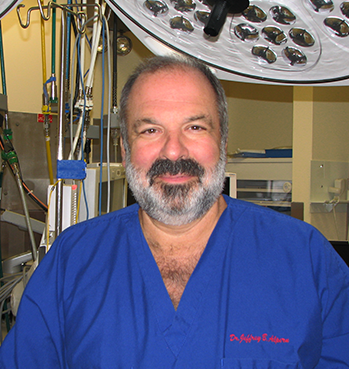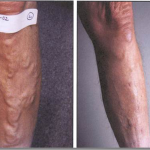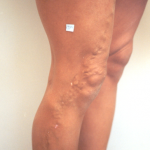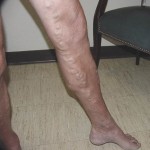Venous System and Vein Disease Overview
 The heart pumps blood rich in oxygen and nutrients through the pressurized arterial system to organs and tissues of the body. The transfer of oxygen and nutrients and exchange with cellular wastes occurs at the smallest blood vessels called capillaries. Blood low in oxygen and carrying cellular wastes is returned to the heart through two venous systems in the legs. These consist of superficial veins just under the skin and deep veins located in the large muscles of the legs. These two systems are connected by short veins called perforator veins.
The heart pumps blood rich in oxygen and nutrients through the pressurized arterial system to organs and tissues of the body. The transfer of oxygen and nutrients and exchange with cellular wastes occurs at the smallest blood vessels called capillaries. Blood low in oxygen and carrying cellular wastes is returned to the heart through two venous systems in the legs. These consist of superficial veins just under the skin and deep veins located in the large muscles of the legs. These two systems are connected by short veins called perforator veins.
Unlike the arterial system which depends on pressure to move blood along, the venous system depends on contraction of muscles in the legs that compress the veins and move blood back towards the heart. In a healthy state, valves in the veins keep blood flowing towards the heart and prevent the backwards flow of blood.
How Incompetent Veins Produce Vein Diseases
The venous system effectively pumps blood out of the legs against gravity unless the valves become incompetent and fail to function normally. Whether in the superficial or deeper veins, incompetent valves produce a reversal in vein blood flow, moving blood back towards the feet when the legs are at rest. The inability of the venous system to drain properly produces increased blood pressure (venous hypertension) in the affected blood vessels that expand or dilate to accommodate the enlarged blood volume.
Associated Symptoms of Vein Diseases
As vein disease progresses, larger veins dilate and become varicose veins. These distended veins can put pressure on nerves causing aching pain, night cramps, restless legs, itchy skin, and unusual sensations on the legs. Distended veins can leak fluid into the surrounding tissues resulting in swelling or edema. A brownish skin discoloration on the skin around the ankle and lower tibial area called hemosiderosis can result from a leakage of the products of blood cell breakdown into these tissues. Venous hypertension also affects the ability of blood to flow across capillary beds, disrupting the exchange of oxygen, nutrients and cellular wastes. The tissues of the leg respond first by thickening and finally by dying. The ultimate consequence of vein disease is a venous stasis leg ulcer with infection of the surrounding skin called cellulitis.
Risk Factors for Incompetent Veins
Many factors including heredity, inactivity, advancing age, and occupations requiring prolonged standing can all be contributing factors for diseases of the veins. Other common predisposing factors are obesity, pregnancy, prior episodes of blood clot formation, trauma, illness, surgery, medication and sedentary lifestyle. During pregnancy, a large increase in blood volume causes veins to enlarge. This combined with pressure on the veins from the growing uterus results in spider and varicose vein formation. Varicose veins generally improve within 3 months after delivery.
Common Vein Treatment Questions
Why should I be evaluated and treated for diseases of the veins?
What can I expect during my initial appointment?
What can I expect during and following my vein treatment procedure?
Who should be evaluated for diseases of the veins?
How can I get a vein screening exam?
More About Vein Treatment and VSA…
Get in touch with VSA
State-of-the-Art Vein Treatment
 You are one step away from the most effective, technologically advanced procedures for the safe and virtually painless treatment of spider veins, varicose veins, venous leg ulcers and chronic venous insufficiency. These state-of-the-art aesthetic and medical procedures are fast, comfortable, without side effects, associated with a rapid recovery, and performed in the office while you remain awake. Procedures for the treatment of venous disease are generally covered by insurance and Medicare.
You are one step away from the most effective, technologically advanced procedures for the safe and virtually painless treatment of spider veins, varicose veins, venous leg ulcers and chronic venous insufficiency. These state-of-the-art aesthetic and medical procedures are fast, comfortable, without side effects, associated with a rapid recovery, and performed in the office while you remain awake. Procedures for the treatment of venous disease are generally covered by insurance and Medicare.
Vein Specialists of Arizona is conveniently located in Phoenix close to Anthem, Avondale, Buckeye, Camp Verde, Casa Grande, Cave Creek, Chandler, Cottonwood, Flagstaff, Gilbert, Glendale, Goodyear, Kingman, Lake Havasu City, Lakeside, Maryville, Mesa, Peoria, Prescott, Prescott Valley, Scottsdale, Sierra Vista, Sun City, Sun City West, Surprise, Tempe, Tucson and Yuma.







